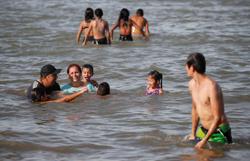Words of caution: Dr Azizan advised the public avoid outdoor activities while Prof Tangang says hot and dry conditions are expected to last for the next two weeks.
PETALING JAYA: Health experts have advised the public to take precautions against heat-related health issues as daytime temperatures are anticipated to soar beyond 35ºC in the coming weeks.
They warn that prolonged exposure to high temperatures can heighten the risk of heat-related ailments, potentially leading to severe health complications.
Malaysian Medical Association president Dr Azizan Abdul Aziz said extremely hot weather can increase the risk of dehydration and heat stroke.
“Children, people engaging in outdoor sports during the day and elderly with long-term health conditions like heart disease or diabetes, are most at risk,” she said, adding that untreated heat stress can lead to heatstroke, which is a medical emergency.
Dr Azizan also advised Muslims to replenish fluids whenever breaking fast, recommending drinking between six to eight glasses of water between iftar and sahur.
“Those going outdoors during the day are advised to use an umbrella and to wear thinner and light-coloured clothing.
“If possible, avoid outdoor activities between 11am to 4pm. The public should also keep themselves updated on any weather developments through official sources,” she added.
According to the Centre for Disease Control and Prevention of the United States, heat stroke, heat exhaustion, heat cramps and heat rash are heat-related illnesses.
Symptoms for heat stroke are hot, red and dry skin, headaches and dizziness, while symptoms for heat exhaustion include heavy sweating, cold, pale and clammy skin, and feeling nauseous.
Heat cramps, meanwhile, have symptoms such as heavy sweating during intense exercise while heat rash results in small clusters of blisters that look like pimples. Heat rashes are usually on the neck, chest, groin or in elbow creases.
Apart from those with existing health conditions, Prof Dr Sharifa Ezat Wan Puteh of Universiti Kebangsaan Malaysia said the disabled, pregnant women and children, were also at risk for heat-related ailments.
“Deter children from playing long hours outside as they may come down with fever.
“Fever with heat spells also may predispose the child to further harm and heat exhaustion,” she said.
She also advised parents whose children were down with fever to get medical attention as soon as possible if they were unsure what to do.
“High temperatures may damage a child’s brain and certain neurological complications may occur,” she said.
For those fasting, Dr Sharifa said the recommended intake of eight glasses of water a day can be broken into a 2:4:2 ratio, where two glasses can be consumed during iftar, four through the night and two during sahur.
“Try to maintain usual food portions instead of having grand feasts for sahur,” she added. Meanwhile, climatologist and Academy of Sciences Malaysia Fellow Prof Dr Fredolin Tangang said the hot and generally dry conditions over the peninsula and Sabah are expected to last for the next two weeks.
He cited several possible factors, namely the impact of the El Nino phenomenon, which is in the weakening phase.
“This typically results in hot conditions over the entire South-East Asia region, especially over northern parts of the peninsula and Sabah,” said Fredolin, who also highlighted how the spring equinox was approaching.
“With less cloud coverage due to El Nino, the amount of heat reaching and absorbed by the earth increases, thus elevating surface temperatures,” he said, adding that the public was advised to pay attention to MetMalaysia’s forecasts.
On Tuesday, MetMalaysia forecast dry and hot weather with temperatures exceeding 35ºC in most places in the peninsula and Sabah over the coming week.












